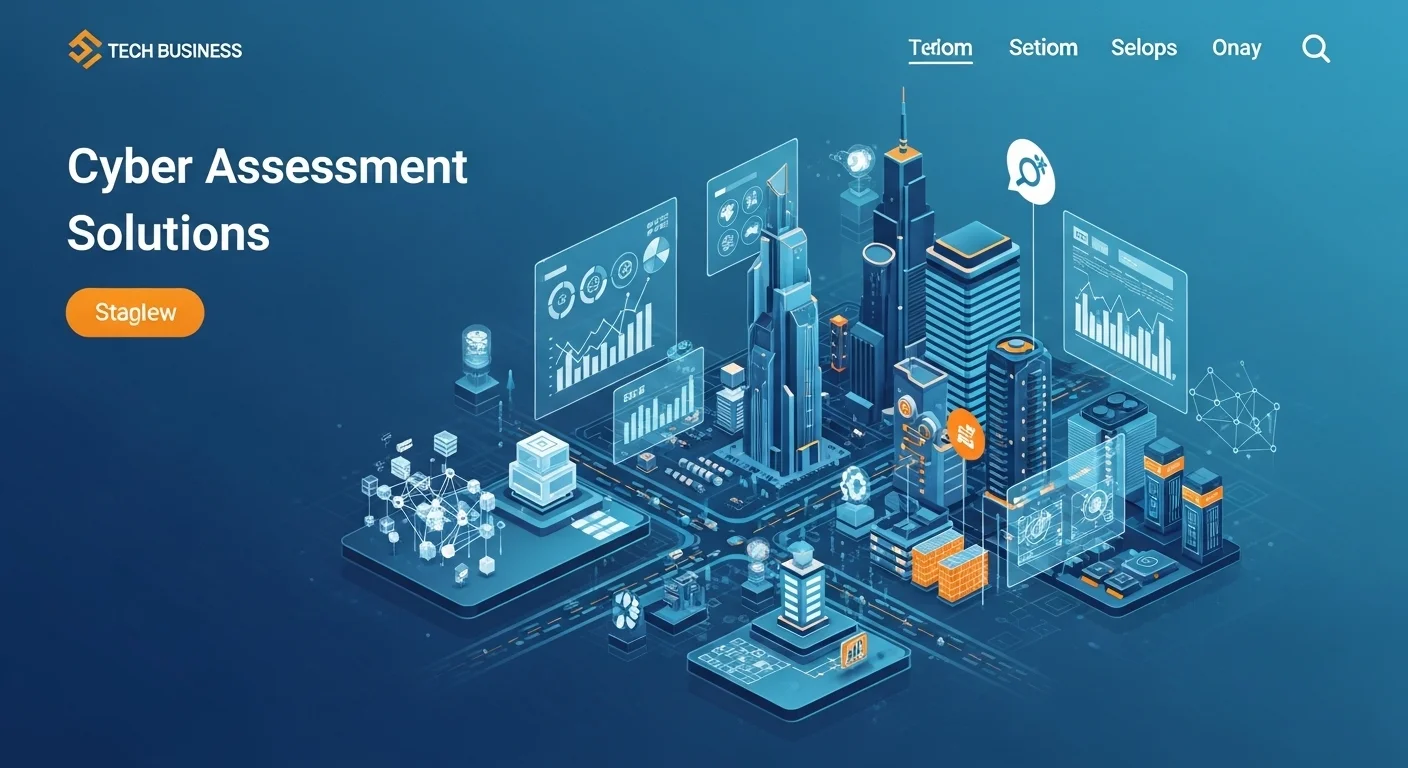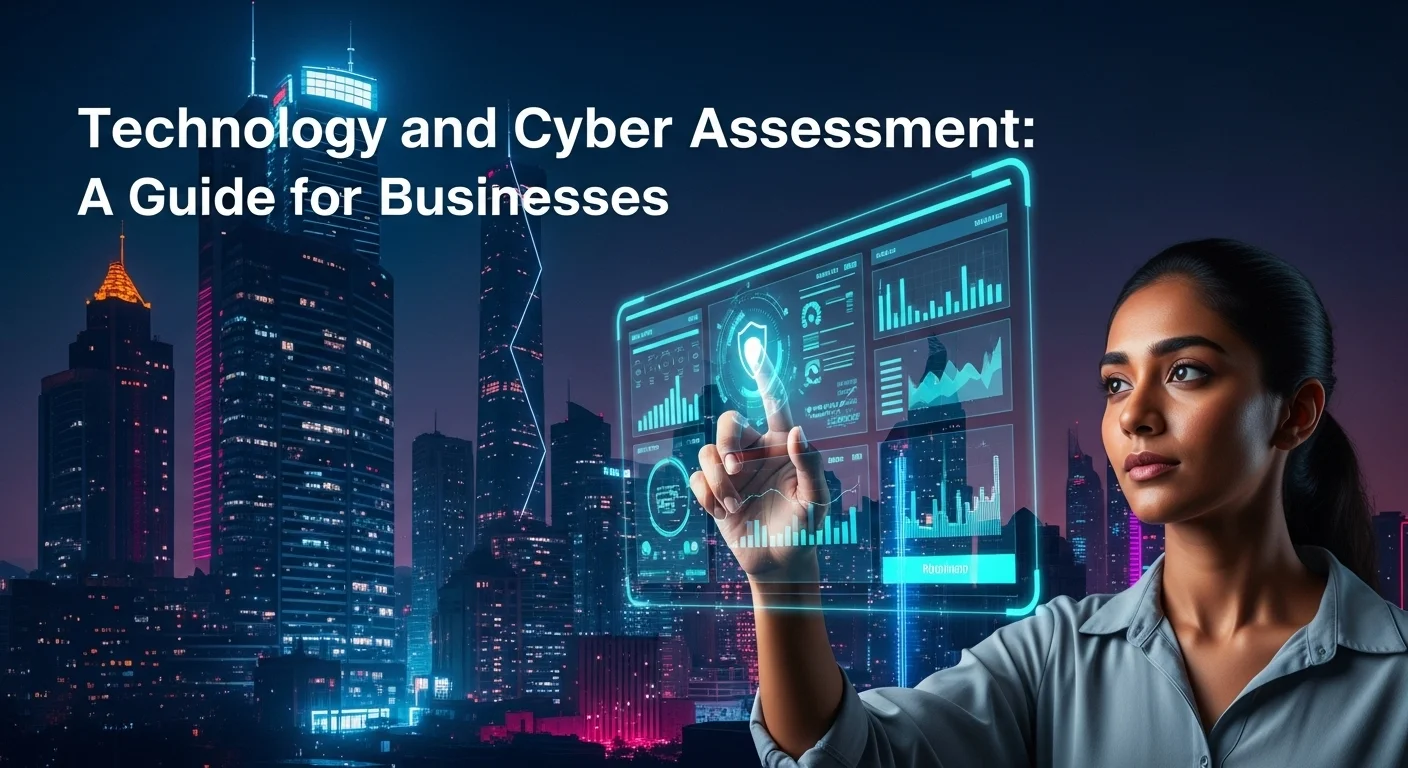What is a Cyber Assessment? A Practical Guide to Protecting Your Business

Executive Summary
In a world driven by technology, feeling secure online can seem complicated. But what if you had a clear roadmap to protect your business? That's what a good cyber assessment provides. It's not just for tech giants; it's a vital tool for any business looking to survive and thrive. In my years working in cybersecurity, I've seen firsthand that understanding your digital weak spots is the first step to building a strong defense. This guide will walk you through the essentials, from what a threat assessment actually looks for to the value of hiring professionals and building true cyber resilience. We'll demystify the jargon and give you the foundational knowledge to manage risks, use technology safely, and protect what you've built.
Table of Contents
Table of Contents
- What is a Cyber Assessment and Why is it So Important?
- Differentiating Key Cybersecurity Concepts
- The Business Case for Cyber Assessments
- Benefits of a Proactive Strategy
What is a Cyber Assessment and Why is it So Important?
In my 15 years in cybersecurity, I've seen digital transformation change everything. It’s exciting, but it also means our businesses are more exposed than ever. A cyber assessment is essentially a top-to-bottom health check for your organization's digital security. Think of it as a diagnostic exam that goes deep into your networks, systems, and data to find vulnerabilities before the bad guys do. The main goal isn't just to find problems, but to give you a clear, actionable plan to fix them. It’s about moving from a reactive mode—putting out fires—to a proactive one where you anticipate and neutralize risks. Honestly, I can't overstate this: a solid security evaluation is the foundation of any resilient and secure business today.
Technology never stands still. We're constantly adding new tools—cloud services, smart IoT devices, AI—and each one, while great for business, can open a new door for attackers. This is where a strategic security review becomes indispensable. It helps you see the security side of your tech choices. For example, if you're moving to the cloud, you need to assess your configurations and data controls. If you're using IoT devices, you need to check their security from the device to the network. Without this kind of evaluation, you're flying blind, and the risks can be huge. A professional threat assessment gives you the visibility you need to make smart, secure decisions about the technology that powers your business.
Differentiating Key Cybersecurity Concepts
It's easy to get lost in the jargon, so let's clear a few things up. People often use these terms interchangeably, but they mean different things:
- Vulnerability Scanning: This is an automated scan, like running a spell-check for known security flaws. It's fast and useful for catching common issues like outdated software, but it's just one piece of the puzzle and doesn't have the context of a full analysis.
- Penetration Testing (Pen Testing): This is where we put on our hacker hats. Ethical hackers simulate a real attack to see how far they can get. It’s a fantastic way to test your defenses in a real-world scenario, but it’s a focused test, not a complete review of your entire security program.
- Cyber Risk Assessment: This is all about connecting technical flaws to business impact. It answers the question, "If this vulnerability is exploited, what would it cost us in money, reputation, or downtime?" A deep cyber threat assessment is a key part of this, helping to prioritize what to fix first.
A full-blown cyber assessment brings all of this together and more. It looks at your policies, your compliance, your system architecture, and even the human element. It gives you that 360-degree view, combining technical findings with your business goals to create a strategic roadmap for getting better.
The Business Case for Cyber Assessments
Let's be clear: cybersecurity is no longer just an IT problem. It's a fundamental business function. A single breach can lead to massive financial losses, hefty fines, legal trouble, and a damaged reputation that can take years to rebuild. A proactive security review is one of the best risk management tools you have, allowing you to patch up holes in your defense before they get exploited.
On top of that, many industries have strict data protection rules. Think of GDPR in Europe, HIPAA in healthcare, or PCI DSS for anyone handling credit cards. These regulations demand regular security check-ups, and failing to comply can be incredibly costly. I often recommend that businesses engage professional cyber security assessment services to navigate these complex requirements. An outside expert brings a level of objectivity and specialized knowledge that's tough to replicate in-house.
Another huge factor is resilience. A cyber resilience assessment specifically measures your ability to take a punch and get back up. It’s not about *if* you'll get attacked, but *when*. This evaluation checks your ability to detect, respond, and recover. How quickly can you get back to business as usual? The answer is critical for long-term survival and helps you build solid incident response and disaster recovery plans.
Benefits of a Proactive Strategy
Investing in a regular, thorough security evaluation program pays off in so many ways that directly impact your bottom line.
- A Stronger Security Posture: This is the most obvious win. By finding and fixing weaknesses, you drastically lower your risk of a damaging attack. Being proactive is always cheaper and less chaotic than cleaning up a mess.
- Smarter Decisions: A detailed threat report gives leaders the data they need to invest wisely in security. It helps you put your resources where the risk is greatest, ensuring your security budget is spent effectively.
- Major Cost Savings: Yes, an assessment costs money upfront, but it's a drop in the bucket compared to the cost of a breach. Studies consistently show that a data breach can cost millions, from investigation and recovery to fines and lost business.
- Building Customer Trust: Customers are savvy about security. When you show you're committed to protecting their data, it becomes a powerful reason for them to choose you over a competitor. Trust is the currency of modern business.
- Gaining a Competitive Edge: In B2B, proving you have strong security is often a requirement to even get in the door. A proactive assessment strategy can open up new partnerships and opportunities.
- Creating a Security Culture: The assessment process involves people from all over the company. It gets everyone thinking about security, turning it into a shared responsibility instead of just an "IT thing." This cultural shift is one of the most powerful long-term defenses you can build.
In short, a cyber assessment is a strategic tool, not just a technical one. It's essential for any business that depends on technology. By understanding threats, getting expert help when needed, and testing your resilience, you build the pillars of a modern, strong digital defense.

Your Complete Guide to Cyber Assessments for Business and Technology
Starting a cyber assessment is a major step for any business. It’s a structured journey that needs a clear plan, the right tools, and a solid grasp of both the technical details and your business goals. I’ve guided countless companies through this process, and I can tell you that a well-executed evaluation gives you a complete picture of your security health. This guide will walk you through the methods and resources available to do it right, ensuring you can effectively tackle your unique cyber risks.
Technical Methods: Looking Under the Hood
The technical part of an assessment involves a hands-on look at your IT infrastructure. Here are the common methods we use to find vulnerabilities.
- Vulnerability Scanning: This is usually our starting point. We use automated tools like Nessus or OpenVAS to quickly scan your systems for known flaws. Think of it as checking all your doors and windows to see if they're unlocked. The tool gives us a list of potential weaknesses, but it takes a human expert to verify the findings and figure out what’s a real threat versus a false alarm.
- Penetration Testing (Pen Testing): This is where we simulate an attack. We actively try to break in to see just how secure your systems are. Depending on the goal, we might do it with zero information (a black-box test, like a real external attacker), full information (a white-box test, for a deep dive), or partial information (a grey-box test, to mimic an insider threat). A good security plan often uses all three to prepare for different scenarios.
- Configuration and Architecture Review: Here, we meticulously review how your key systems—firewalls, servers, cloud services—are set up. A simple misconfiguration, like a weak password policy or an unnecessary open port, can create a huge security hole. We also look at the overall design of your network to find any foundational flaws. This is a crucial part of a cyber resilience assessment because a strong architecture is the backbone of a resilient system.
- Social Engineering Tests: Let's be honest, people can be the weakest link. We test this by sending fake phishing emails or making pretext phone calls to see how employees respond. It sounds a bit sneaky, but the results provide invaluable feedback for security awareness training and help build a more vigilant team.
- Red Teaming vs. Blue Teaming: This is like a live fire exercise for your security team. Our Red Team (the attackers) launches a simulated, multi-stage attack, while your Blue Team (the defenders) has to detect and shut it down. It’s an incredibly effective way to test your real-world detection and response capabilities and sharpen your team’s skills.
Business Strategy: Connecting Tech to the Bottom Line
A successful evaluation must speak the language of business. Technical findings are useless unless leadership understands the risks. Here’s how we bridge that gap.
- Risk Assessment Frameworks: To keep things structured, we use established frameworks. The NIST Cybersecurity Framework is a popular, flexible choice. ISO 27001 is an international standard perfect for organizations wanting formal certification. Frameworks like these provide a repeatable, logical approach to managing security risks. I help clients choose the one that fits their industry and maturity level.
- Threat Modeling: This is a creative, proactive exercise where we think like an attacker. We brainstorm all the ways a system could be attacked using methods like STRIDE. I find this most powerful when done early in a project’s development, as it helps build security in from the start, rather than bolting it on later. A comprehensive cyber threat assessment is at the heart of this process.
- Business Impact Analysis (BIA): A BIA answers a critical question: what happens to the business if a system goes down? It identifies your most critical operations and calculates the financial and operational impact of an outage over time. This analysis is essential for setting recovery goals and building a solid business continuity plan, which is a key part of any cyber resilience assessment.
- Compliance Audits: If you're in a regulated industry, audits for rules like GDPR, HIPAA, or PCI DSS are mandatory. These check if you’re meeting your legal obligations. While compliance isn’t the same as security, it provides a strong baseline. Navigating these audits can be tricky, which is why many businesses turn to specialized cyber security assessment services.
Resources: Making the Right Choice
You have options for conducting an assessment. The right choice depends on your budget, in-house expertise, and need for an objective view.
- In-house vs. Outsourced: Your internal team knows your business inside and out, but they might have blind spots or lack specialized skills. Bringing in a third-party expert provides a fresh pair of eyes, deep expertise, and an unbiased perspective. I've often seen a hybrid approach—your team working with external specialists—deliver the best results.
- Automated vs. Manual Testing: Automated tools are great for speed and scale, but they can't think like a human. A skilled ethical hacker can find complex flaws in logic that tools will always miss. The best assessments, in my experience, always combine the efficiency of automation with the insight of manual testing.
- Open-Source vs. Commercial Tools: There are fantastic tools on both sides. Open-source options like Metasploit and Nmap are powerful and free, but might require more technical skill. Commercial tools often offer slicker interfaces and dedicated support but come at a cost. The right toolset depends on your team's skills and your budget.
Ultimately, a complete cyber assessment is a strategic blend of deep technical work and sharp business insight. By using a mix of methods and choosing the right resources, you can gain a clear, actionable understanding of your security. The goal is to build a dynamic defense that can adapt to the ever-changing threats out there, driven by a continuous cycle of assessing, fixing, and monitoring.

Practical Tips and Strategies to Master Your Cyber Assessment
Getting through a cyber assessment is one thing; using it to truly improve your organization's security is another. As someone who has been in the trenches of cybersecurity for years, I want to share some practical tips and advanced strategies. The goal is to move beyond just checking a box for an audit and turn this process into a powerful engine for building real resilience. These best practices will help you translate your assessment results into a safer technology experience for everyone.
Best Practices for an Effective Program
To get the most value, think of your security evaluations as an ongoing program, not a one-time project. Here’s how to do it right:
- Make It a Continuous Loop: The digital world changes daily. An assessment from last year is already outdated. The best approach is a continuous model with regular automated scans, periodic pen tests, and constant monitoring. This gives you a near real-time view of your security, so you can spot and fix new issues fast.
- Bake Security into Your Development (DevSecOps): Don't wait until a product is finished to think about security. By integrating security checks, like threat modeling and code analysis, right into your development process, you can catch flaws when they are cheapest and easiest to fix. This proactive mindset is a key part of any modern threat assessment strategy.
- Prioritize Based on Real Risk: You'll likely get a long list of findings. You can't fix everything at once. The key is to prioritize based on business risk. Ask yourself: how critical is the affected system? How likely is an attack? What would the impact be? This risk-based approach ensures you focus your energy on what matters most.
- Create a Clear Action Plan: Finding a problem is only half the job. You need a clear, actionable plan to fix it. This plan should name who is responsible, set realistic deadlines, and include a way to track progress. I always stress that this has to be a team effort between security, IT, and business leaders.
- Train Your People: Your employees are your first line of defense. Regular, engaging security awareness training helps them spot threats like phishing. I've found that backing this up with occasional simulated phishing tests is incredibly effective. A well-trained team is a cornerstone of a strong cyber resilience assessment because it dramatically reduces human error.
Advanced Strategies and Tools for the Next Level
Once you've mastered the basics, you can adopt more advanced strategies to sharpen your defenses.
- Embrace AI and Machine Learning: AI is a game-changer for security evaluations. AI-powered tools can sift through massive amounts of data to find subtle signs of a threat that a human might miss. They can help automate analysis and even predict future attacks, freeing up your security team to focus on the biggest threats.
- Set Up a Security Command Center (SIEM/SOAR): A SIEM platform gathers all your security logs into one place, giving you a single pane of glass to monitor for threats. A SOAR platform takes it a step further by automating responses to common incidents. Together, they dramatically speed up your ability to detect and respond to attacks in real time.
- Use Governance, Risk, and Compliance (GRC) Tools: GRC platforms are fantastic for managing your overall risk program. They centralize your policies, controls, and assessment results, helping you track compliance with various regulations automatically. A good GRC tool can be a lifesaver for managing a complex, ongoing assessment program.
- Tune Into Threat Intelligence: Subscribing to threat intelligence feeds gives you the latest scoop on new threats, vulnerabilities, and attacker tactics. This information is gold because it helps you focus your cyber threat assessment on the dangers most likely to target your specific industry.
Lessons from the Field
The value of a solid assessment program really hits home when you see it in action. I remember a client, a mid-sized e-commerce company, that hired us for cyber security assessment services. We found a critical flaw in their payment app that could have exposed all their customer credit card data. By fixing it proactively, they dodged a bullet that would have cost them millions and shattered their customers' trust.
On the flip side, I worked with a healthcare provider who had put off regular assessments. They were crippled by a ransomware attack that exploited a known, unpatched vulnerability. All their patient records were encrypted, and the fallout—from the ransom payment to regulatory fines and community backlash—was devastating.
The lesson is simple: a proactive investment in a comprehensive cyber assessment is one of the smartest business decisions you can make. It’s the difference between controlling your own fate and leaving it to chance.
Where to Go for More Information
Cybersecurity is always changing, so continuous learning is key. Here are a few excellent resources I always recommend:
- NIST (National Institute of Standards and Technology): They offer a treasure trove of free resources, including the Cybersecurity Framework—a must-read for any organization serious about security.
- SANS Institute: A top-tier source for training and research. They offer many free webcasts and papers that are great for staying current.
- OWASP (Open Web Application Security Project): If you build or run web applications, OWASP is your best friend. Their Top 10 list of web security risks is an industry-standard guide.
In the end, improving your security through a strategic assessment program is entirely achievable. By following these best practices, using advanced tools, and staying informed, you can build a defense that is both effective and resilient. View your cyber assessment not as a cost, but as a strategic investment in your company's future. It's how you build a business that is ready for anything.
Expert Reviews & Testimonials
Sarah Johnson, Business Owner ⭐⭐⭐
The information about Cyber Assessment is correct but I think they could add more practical examples for business owners like us.
Mike Chen, IT Consultant ⭐⭐⭐⭐
Useful article about Cyber Assessment. It helped me better understand the topic, although some concepts could be explained more simply.
Emma Davis, Tech Expert ⭐⭐⭐⭐⭐
Excellent article! Very comprehensive on Cyber Assessment. It helped me a lot for my specialization and I understood everything perfectly.



